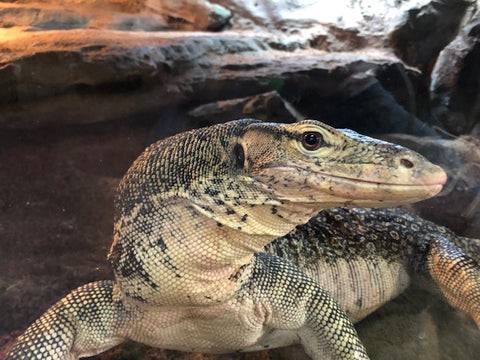Thinking about welcoming an exotic reptile into your home? The Asian water monitor, a creature of impressive size and intelligence, might have caught your eye. But before you envision this magnificent lizard basking in your living room, it’s crucial to understand what it truly means to keep Varanus salvator as a pet. Are these fascinating creatures suitable companions, or are they better admired from afar? Let’s dive into the realities of Asian water monitor ownership.
Understanding the Asian Water Monitor
The Asian water monitor (Varanus salvator) is a member of the Varanidae family, a group that includes around 50 species, most famously the Komodo dragon. These ancient reptiles boast a lineage stretching back millions of years. Recognizable by their robust, muscular bodies and powerful tails, Asian water monitors typically exhibit dark brown to black coloration, often accented with yellow spots on their undersides, though these can fade with age. They possess elongated snouts and long necks, contributing to their impressive size. Equipped with serrated teeth, strong jaws, and sharp claws, they are formidable animals, well-prepared for both hunting and defense.
 Elvis The Asian Water Monitor Lizard Relaxing at Reptile Zoo
Elvis The Asian Water Monitor Lizard Relaxing at Reptile Zoo
These semi-aquatic lizards are closely tied to water, spending significant time in and around it. Adaptable to both freshwater and saltwater environments, Asian water monitors are also surprisingly agile on land, known for their speed and ability to climb trees with ease. Their aquatic prowess is further highlighted by their ability to remain submerged for up to 30 minutes – a remarkable adaptation for hunting and evading predators.
Diet and Feeding of Your Water Monitor
Asian water monitors are carnivores with a hearty appetite for meat. In their natural habitat, their diet is diverse, encompassing insects, rodents, frogs, smaller birds, snakes, and even eggs. Observations in regions like Thailand and Malaysia have shown them consuming crabs and fish, showcasing their adaptability to available prey. In captivity, replicating this varied diet is key to their health and well-being. A proper diet should include appropriately sized rodents (mice, rats), fish, insects, and occasionally, as a treat, eggs. It’s important to avoid overfeeding and to ensure food items are ethically sourced and of high quality.
Size and Housing Requirements for Pet Water Monitors
When considering an Asian water monitor as a pet, their adult size is a crucial factor. These lizards typically reach lengths of 4 to 6 feet and can weigh between 40 to 90 pounds. However, exceptional individuals can grow even larger, with the record standing at an astonishing 10.5 feet and 165 pounds. This substantial size dictates the need for equally substantial housing. Forget about a typical glass tank; adult Asian water monitors require custom-built enclosures. These enclosures must be spacious, secure, and designed to mimic their natural environment, including both terrestrial and aquatic areas. A large water feature for swimming and soaking is essential, along with ample land space for basking and exploration. Temperature and humidity control are also critical, requiring specialized heating and lighting equipment to maintain optimal conditions.
Lifespan and the Long-Term Commitment
Asian water monitors have a considerable lifespan, living up to 25 years in captivity with proper care. This longevity means that taking on an Asian water monitor is a decades-long commitment, comparable to owning a dog or cat in terms of time. Prospective owners must be prepared for the long-term responsibility, including the financial implications of food, housing maintenance, and potential veterinary care over many years.
Temperament and Handling of Asian Water Monitors
While often described as “docile,” it’s important to understand that an Asian water monitor’s temperament is complex and heavily influenced by its environment and handling. They are not domesticated animals and retain their wild instincts. While not typically aggressive towards humans unless provoked, they can bite, scratch with their sharp claws, and use their powerful tails as whips if they feel threatened. Handling requires caution and respect for their size and strength. Regular, gentle interaction from a young age can help some individuals become more accustomed to human presence, but they are generally not cuddly pets. It’s also worth noting that while their venom is not considered lethal to humans, a bite can still cause pain and potential infection due to bacteria in their mouths, requiring medical attention.
The Reality of Asian Water Monitors as Pets
So, can you have an Asian water monitor as a pet? Technically, in many areas, it is legal, and they are available through the pet trade. However, legality and availability do not equate to suitability for all pet owners. Asian water monitors are undeniably fascinating and intelligent creatures. However, they demand a significant commitment of time, space, and resources far beyond that of typical pets. They are not suitable for beginner reptile keepers or those seeking a low-maintenance companion. Ideal owners are experienced reptile enthusiasts with a deep understanding of exotic animal care, the resources to provide for their complex needs, and a realistic expectation of their temperament. Before considering an Asian water monitor, thorough research, careful self-assessment, and ideally, consultation with experienced keepers or reptile professionals are essential to ensure both the animal’s well-being and the owner’s preparedness for this extraordinary, yet demanding, pet.